Традиции казахского народа кратко на английском
Обновлено: 02.07.2024
Презентация на тему: " TRADITIONS AND CUSTOMS OF THE KAZAKH PEOPLE. преподаватель английского языка Имангазиева Ш.Т." — Транскрипт:
1 TRADITIONS AND CUSTOMS OF THE KAZAKH PEOPLE. преподаватель английского языка Имангазиева Ш.Т.
2 SOUL OF THE PEOPLE IN ITS TRADITIONS
5 TRADITIONS AND THE CUSTOMS OF THE KAZAKH PEOPLE CONNECTED WITH RECEPTION OF GUESTS ШАШУ АТ МИНГИЗИН ШАПАН ЖАСУ БАТА БЕЛКОТЕРЕР БЕС ЖАКСЫ ЕРУЛИК ЖЫЛУ КОРИМДИК И БАЙГАЗЫ КОНАКАСЫ КОНАККАДЕ
7 ОБЫЧАЙ ГОСТЕПРИИМСТВА "АТ МИНГИЗИП ШАПАН ЖАБУ Ат мингизип шапан жабу" - самый высокий почет. У казахского народа есть обычай: дорогому гостю, акыну, батыру, борцу или уважаемому человеку дарить коня и накидывать на плечи чапан. Этот обычай гостеприимства продолжает жить и в наши дни
8 БАТА Бата - благословение перед дальней дорогой, испытаниями, благодарность за угощение, гостеприимство, доброту. Это особый вид поэтического творчества. Благословение произносят обыкновенно старшие по возрасту аксакалы
9 БЕЛКОТЕРЕР - ОБЫЧАЙ ГОСТЕПРИИМСТВА Белкотерер - угощение для пожилых людей. Они нуждаются в особом уходе. Для них готовится вкусное, мягкое угощение: козы, сливочное масло, жент, кумыс, творог, мед и т.д. Его готовят и приносят дети, соседи, близкие. Эта традиция служит примером заботы о родителях, пожилых людях.
10 БЕС ЖАКСЫ ЕРУЛИК Ерулик - угощение вновь прибывшим соседям (новоселам). Новоселов приглашают к себе в гости, чтобы они быстро привыкли к новой среде. Эта традиция имеет как социальную, так и общественную значимость. У новоселов первое время не бывает, к примеру, дров или питьевой воды. В это время и приходят на выручку соседи Пять ценных вещей. "Бес жаксы" дарили самым уважаемым и почитаемым людям. В него входили: 1. Верблюд - "кара нар". 2. Быстроногий скакун - "жуйрик ат". 3. Дорогой ковер (персидский) - "калы килем". 4. Алмазная сабля - "алмаз кылыш". 5. Соболья шуба - "булгын шик
11 ЖЫЛУ "Жылу" - материальная помощь. Людям, пережившим стихийные бедствия, несчастья (пожар, наводнение и пр.), окозывают материальную, моральную, финансовую поддержку. Для этого не обязательно быть родственником или близким. Для возмещения ущерба пострадавшим выделяют скот, жилье, одежду и пищу. "Жылу" (от слова жилы - тепло) - проявление человечности, доброты, сочувствия. КОРИМДИК И БАЙГАЗЫ Подарок, который дают за увиденных впервые молодую невестку, новорожденного, верблюжонка. "Коримдик" - от слова "кору" - смотреть, видеть. "Коримдик" служит для выражения добрых намерений родственников, близких. "Байгазы" и "коримдик" - разные понятия. "Коримдик" дается за людей или животных; "байгазы" - за обновку или какие- либо другие вещи, предметы.
12 КОНАКАСЫ "Конакасы" (конек - гость, ас - угощение). Казахский народ славится своим гостеприимством. Встретить гостя с почетом, угостить его - знак щедрости. Все самое вкусное казахи всегда хранили для гостей. Гостей делили на три вида. "Арнайы конек" - специально приглашенный, "кудайы конек" - случайный путник, "кыдырма конек" – нежданный гость. Человека, не давшего "конекасы", штрафовали (штраф - лошадь, верблюд и т.д).
13 КОНАККАДЕ Конаккоде" (конек - гость; коде - подарок). Хозяин дома имеет право попросить своего гостя выполнить "конеккоде", то есть спеть песню и т.д. Казахи с ранних лет учат своих детей красноречию, играть на музыкальных инструментах, петь, слагать стихи. "Конаккоде" - испытание гостя в искусстве, а также залог веселого застолья.
14 Наречение ребенка. Колыбель. Когда в молодой семье появляется малыш бабушка, дедушка или самый старший из родственников дает ему имя. Он наклоняется к уху малыша и трижды проговаривает: Твое имя.
15 Когда малышу исполнится несколько дней, его укладывают в колыбель, которую для него дарит родственница мамы. Ей доверяют в первый раз уложить ребенка. Сначала она изгоняет злых духов над кроваткой с помощью зажженной палочки. Стелет маленькие подушки и одеяла. Потом пеленает малыша и специально сшитыми лентами перевязывает его в трех местах. Накрывает шапаном (головной убор), шубкой, чтобы малыш был сыном народа, вешает уздечку и плетку, чтобы стал хорошим наездником, прикрепляет туман (талисман), чтобы не сглазили, привязывает когти беркута, чтобы имел зоркий глаз.
17 АТКОЮ Наши предки особое значение придавали такому детскому обряду, как ат кою (наречение) или Азан Шакыру (зов). Суть обряда ат кою заключалась в том, что через сорок дней после рождения ребенка собирались аксакалы аула и с утренней молитвой давали ему имя. Обычно имя давал старший из родственников. Мулла произносил молитву и три раза произносил в ухо ребенку его имя
18 БЕСИК САЛУ БЕСИК САЛУБЕСИК САЛУ У казахов существовал интересный обычай - бейсик салу, в переводе означающий "класть в колыбель". Этот обычай доверяли киндяк шоше (вторая мать). Она накрывала младенца семью вещами: специальным одеялом, халатом, кибинеком (войлочным плащом), шубой и сверху, если младенец мальчик, клали узду и нагайку, для того чтобы он вырос хорошим наездником и нож, чтобы отпугнуть злых духов, а если младенец девочка - зеркальце и расческу, чтобы она выросла красавицей.
19 ТУСАУ КЕСУ. РАЗРЕЗАНИЕ ПУТ. Из традиционных детских обрядов у казахов наиболее интересным был тусау кесу (разрезание пут). Ребенку начинающему ходить перевязывали ноги черно-белым шерстяным шнуром, который затем перерезала многодетная, энергичная, подвижная женщина, передавая ему тем самым свои качества. Разрезанный шнур затем сжигали. Тусау кесу (разрезание пут) очень символичен:для ребенка как бы открывалась новая жизнь, а черно- белый шнур символизировал жизнь с ее непостоянством, впереди было много испытаний и их надо пройти достойно.
20 Сундет той Сундет той - той, посвященный обряду обрезания. Этот обряд впервые появился в арабских странах, затем распространился по всем мусульманским народам. Обряд обрезания делают мальчику в 5-7 или 9- летнем возрасте, обычно весной или осенью. Сундет той считался важным и радостным событием в жизни мальчика. На праздник приглашали самых близких родственников и друзей. Устраивали различные состязания, игры. Мальчику, которому сделали обрезание, дарили подарки, сладости. Обряд обрезания считается долгом каждого мусульманина, является символом мусульманства.
21 Посвящение в наездники Когда мальчику исполняется 4-5 лет, его посвящают в наездники. Для него делают ашамай-ер (специальное седло из дерева). Выбирают самого спокойного жеребенка-трехлетку и сажают на него ребенка. Отец водит коня по всему аулу для того, чтобы малыш поприветствовал всех людей. Женщины бросают шашку (подарки и сладости). Оседлав своего первого коня, мальчик по праву может считать себя мужчиной
22 Посвящение в науку (Тилашар - той Когда ребенку исполнялось 7 лет, родители вели его в школу. Это большое и радостное событие в жизни ребенка. В честь этого праздника его родители устраивали той. Приглашенные гости поздравляли родителей, желали удачи их ребенку, дарили подарки. Для этого случая резали барана, устраивали большое пиршество для гостей. Аксакалы давали свое благословение ребенку, впервые в своей жизни идущему на учебу.
23 Первый отъезд мальчика из родительского дома (Токум кагу) Когда ребенок научится самостоятельно ездить верхом, он впервые выезжает из дома. В этот день приглашают уважаемых людей почтенного возраста. Гости играют на домбре, поют песни, играют в разные игры. Этот той устраивали в честь первого отъезда сына и его благополучного возвращения.
25 Свадебные обычаи казахского народа Смотрины казахов перед свадьбой. Кыз Кору Смотрины. "Кыз керу" иногда называли и "кыз тандау". По обычаю дети знаменитых людей или просто искусные джигиты устраивали смотрины девушек для женитьбы. Прослышав, что в дальнем ауле есть хорошая, красивая девушка на выданье, джигиты со своими друзьями отправлялись выбирать суженую.
27 Обряд открывания лица невесты перед свадьбой казахов. Беташар Беташар - обряд открывания лица невесты (показа невесты родственникам жениха и гостям) обязательно сопровождается традиционной песней-жыр. В юрту отца жениха, где собираются гости, приводят невесту в свадебном наряде. По обе стороны невесты, взяв ее под руки, стоят учтивые, благовоспитанные снохи. В "беташар" входит знакомство невесты с родственниками мужа, их добрые советы и пожелания на будущее в семейной жизни. Певец- импровизатор, характеризуя в стихах почтенных родственников, призывает невесту поклониться каждому; в ответ на это близкие родственники мужа дают "керзмшк" (подарок "за погляд"). "Беташар" заканчивается наставлениями, пожеланиями, советами.
28 Бешбармак - казахское национальное блюдо Если перевести дословно - "беш" по-казахски - пять, а "бармак" - палец/пальцы. Казахские и другие кочевые племена не использовали во время еды столовые приборы, а брали мясо руками - отсюда и название :-) Блюдо готовится из баранины, говядины и конины. Поскольку, конина не всем доступна, бешбармак можно готовить, из соображений доступности, из баранины и говядины или из одного вида мяса.
29 Beshbarmak is traditionally made from horse meat, mutton or beef. The ingredients for the preparation of the following: one and a half-two kg of beef or lamb, onion (4-5 bulbs), herbs, black pepper, salt, Bay leaf, 0,5 kg of wheat flour, 2 eggs. the recipe of Beshbarmak
34 Баурсаки - обязательное угощение в каждой казахской семье. Сейчас не только казахи их готовят и едят. Подают баурсаки к чаю, перед едой, к кумысу, к закускам, к сорпе. Это и праздничное, и повседневное блюдо, любимое всеми от мала до велика. мука, простокваша, дрожжи, сахар, соль, масло растительное
35 Products: Flour, 4 cups Sour milk - 1 glass Yeast - 1 tablespoon Sugar - 1 tbsp (if you want to baursak make sweet, add 3 spoons of sugar) Salt a pinch of vegetable oil g. the recipe
36 Preparation Knead the dough. Замесить тесто. In curds dissolve the sugar and yeast, add the flour, salt and knead the dough into a ball. В простокваше распустить сахар и дрожжи, добавить муку, соль и вымесить тесто в шар. Put the bowl with the dough in a warm place and cover with a towel. Not less than 5 hours. Поставить миску с тестом в теплое место и накрыть полотенцем. Не меньше, чем на 5 часов.
37 Стол и руки смазать растительным маслом. Тесто вывалить на стол и хорошо вымесить. Разделить на небольшие кусочки. Совсем небольшие. Скатать эти кусочки в шарики и оставить на столе минут на пять, чтобы они поднялись. The table and hands greased with vegetable oil. The dough is poured on the table and knead well. Divide into small pieces. Quite small. Roll the pieces into balls and leave on the table for five minutes for them to come up. Разогреть в кастрюльке масло. Шарики, по одному, выкладывать, помешивая сухой ложкой. Жарить на среднем огне, постоянно помешивая со всех сторон. Heat the oil in a saucepan. Balls, one by one, spread, stirring spoon dry. Fry on medium heat, stirring constantly, to baursak from all sides. Шумовкой выложить баурсаки в миску, выложенную бумажными салфетками. Салфетки нужны для того, чтобы в них впиталось лишнее масло. The skimmer put baursak in a bowl, which was lined with paper towels. Napkins are needed for it to them absorbed excess oil.
38 Казахские традиционные блюда
40 дастарханға бата Шаңырақ шалқи берсін. Керегең кеңи берсін. Осы үйге ән-күй келсін, Дұшпаның кеми берсін. Дастарханға береке берсін. Күнде мереке болсын. Қастық ойлағандар, Қабағы ашылмай келеке болсын
Свидетельство и скидка на обучение каждому участнику
Зарегистрироваться 15–17 марта 2022 г.

- Поможем развить концентрацию и внимание с раннего возраста
- Повысим гибкость и раскованность в общении
Описание презентации по отдельным слайдам:

Traditions and customs of the Kazakh people
Kyz Uzatu (Marriage) Seven or more people from the groom's side would come one day to take the bride back to their house. Whatever the number, it had to be odd. Godparents came first, then the groom would come with his friends. Below we try to describe the "Kyz Uzatu" ceremony.
"Shashu" - was mentioned earlier. When the groom came to the bride's house, one of the respected woman of the aul would throw shashu or special treats. Everyone would try to catch one, for this would indicate a successful marriage for their daughter too.

Customs, legends and ceremonies connected to child’s birth and upbringing. Shildehana is a child’s birth celebration. Kalzha is ceremonial treating of parturient woman in the first day of parturition. This is care about parturient woman and symbol of respect and kindness. This celebration is made nowadays usually on the 40th day after the child’s birth. The mother of parturient woman brings sheep, “kalta” or “korzhyn” with foodstuff and gifts for this celebration. The mutton meat is prepared, trimmings and “kalta” are given out. The presence of men is unacceptable. Their appearance may allegedly result in baldness. Joyful celebration is accompanied by songs, jokes and laughter. Besikke salu, besik toy is a holiday arranged after the child’s putting to cradle (in 3-5 days after umbilical cord falling off).


Esim koyu, at koyu is a holiday of name giving to the child. This holiday is celebrated during “shildehana” or on the 3rd day after the child’s birth and child’s putting to cradle (“besik toy”). The ceremony is made by respected people, who bless newborn child. Kyrkynan shygaru is a holiday, celebrated on the 40th day after the child’s birth. This is a ceremony of the child’s bathing in forty-spoons-water, first hair and nails cutting. Tusau kesu are the child’s first steps. According to the Kazakh custom the oldest and the most respected man in aul is invited to “yurta”, where the child has made his first steps in order to cut strings by the knife tied around the child’s legs. Lately, this celebration is committed to the man (usually from relatives), who walks fast. Sundetke otyrgyzu (circumcision). In this day parents of 5-7-year-old son invite venerable mullah, who makes circumcision. After that, the child’s parents generously reward him. On this occasion, many guests are invited and give presents to the child and his parents.

Kyz kuu. National horseracing game is carried out on the racecourse of hippodrome. The game distance is 300-400 m. Two movable flags are set on the start in 10 meters from each other. The girl starts at the first flag. Crossing of the flags line by the girl gives the right to dzhigit to catch her. It is necessary to let through all pairs in one side consistently one by one for convenience. Then at the same order the girl is given the right to catch dzhigit. The main point of the game is to catch the girl. If dzhigit catches the girl, he becomes the winner and may kiss her. If the girl catches dzhigit, she becomes the winner and may hit him by “kamcha”.
У казахского народа существует большое количество обычаев и традиции, одна из них, это:
АУЫЗ ТИЮ - "отведать угощение"
Древний обычай казахского народа. Кто бы ни пришел в дом, казах его не отпустит, пока гость не отведает угощения. Ауыз тию и означает "отведать, попробовать еду". В любое время, независимо от того, сидят ли в доме за трапезой или нет, казашки выставляют на дастархан угощение или просто хлеб и просят гостя отведать. "Завтрака не оставляй, а ужина не жди", - говорят казахи. По традиции, вошедший в дом во время завтрака обязательно должен сесть за стол и позавтракать вместе с хозяевами. В обратном случае прозвучит шутка: "муж бросит" - женщинам, "жена убежит" - мужчинам.
Отправляясь в поездку, в длительное путешествие, каждый перед отъездом должен отведать угощенье в доме. Провожая детей в армию, родители собирают на стол, т.е. замечательный обычай сохраняется и сегодня.
Auyz Tia - "taste treat"
The ancient custom of Kazakh people. Anyone who comes to the house, it will not release the Kazakh as guest did not taste the food. Auyz ment of and means "to taste, to taste the food." At any time, regardless of their sitting at table in the house or not, Kazakhs put on tablecloth meal or just bread and ask the guest to taste. "Breakfast not leave, and dinner, do not wait," - said the Kazakhs. According to tradition, entered the house at breakfast time must sit down and have breakfast with the hosts. Otherwise hear a joke: "husband left" - women, "the wife will run away" - men.
When you travel, on a long journey, everyone should try before leaving treats in the house. Taking your children to the army, the parents gather at the table, that is, wonderful tradition continues today.

Презентацияда қазақ халқының салт-дәстүрлері ағылшың тілінде берілген. Kazakhs have always revered and highly valued their national customs and traditions.Travelers in Kazakhstan are most likely to be encountered with the traditions, associated with guest reception.Traditions and customs associated with the guest reception
Kazakh traditions

Kazakh traditions

Kazakh traditions
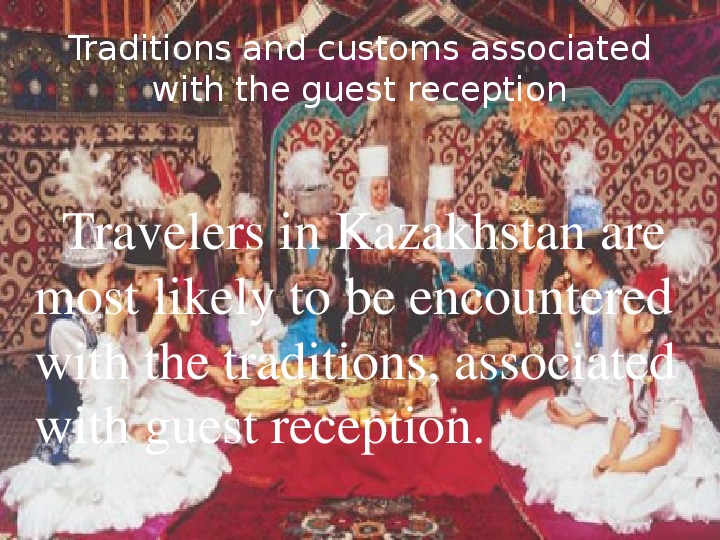
Traditions and customs associated with the guest reception Travelers in Kazakhstan are most likely to be encountered with the traditions, associated with guest reception.
Kazakh traditions
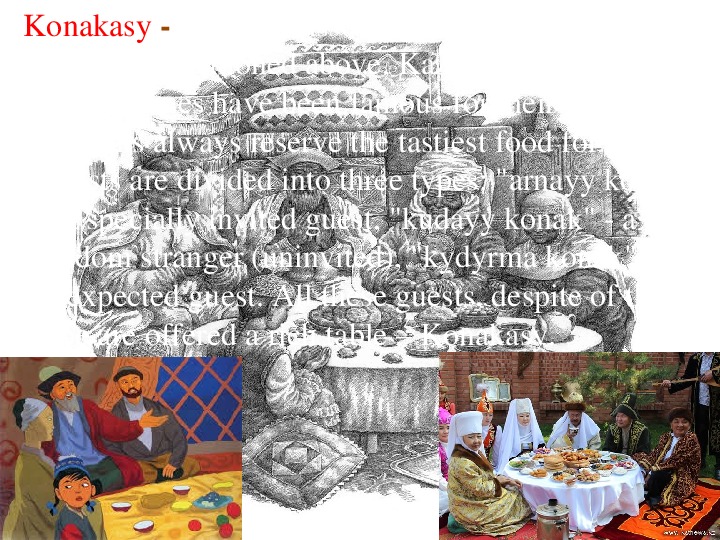
Konakasy a custom associated with treating of a guest. As mentioned above, Kazakh people since ancient times have been famous for their hospitality. Kazakhs always reserve the tastiest food for guests. Guests are divided into three types: "arnayy konak" is a specially invited guest, "kudayy konak" a random stranger (uninvited), "kydyrma konak" an unexpected guest. All these guests, despite of their type are offered a rich table – Konakasy.
Kazakh traditions
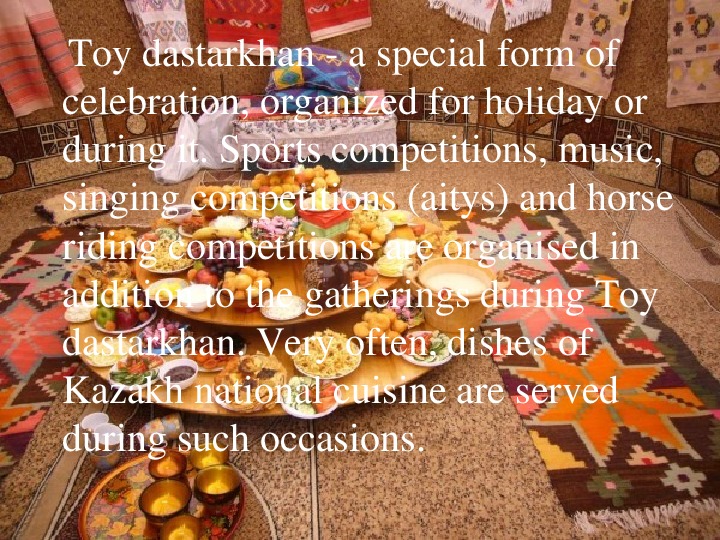
Toy dastarkhan a special form of celebration, organized for holiday or during it. Sports competitions, music, singing competitions (aitys) and horse riding competitions are organised in addition to the gatherings during Toy dastarkhan. Very often, dishes of Kazakh national cuisine are served during such occasions.
Kazakh traditions

Traditions and customs associated with gift giving Suyіnshі a custom according to which a traveller or any other person who brought home a good message (news) receives a valuable gift from the owners in gratitude. Sometimes before telling good news a person says ‘Suyunshi’ or ‘what would you give me for a Suyinshi?’, thus implying that he or she has something great to tell.
Kazakh traditions

Kazakh traditions
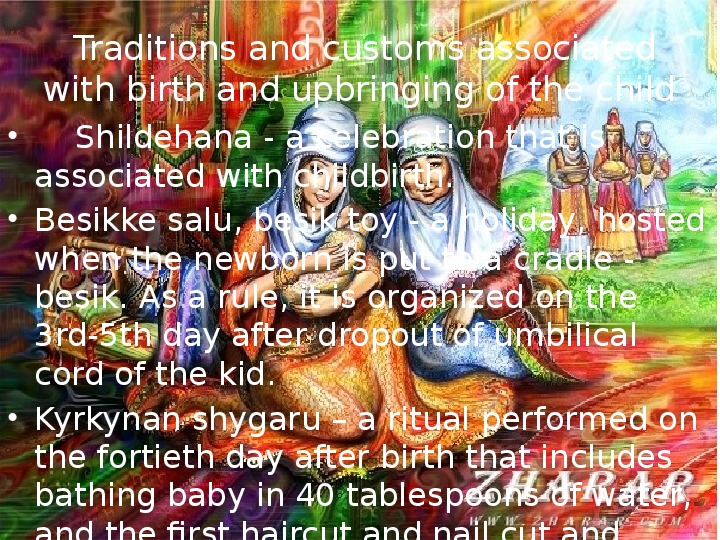
Traditions and customs associated with birth and upbringing of the child • Shіldehana - a celebration that is associated with childbirth. • Besіkke salu, besik toy - a holiday, hosted when the newborn is put to a cradle - besik. As a rule, it is organized on the 3rd-5th day after dropout of umbilical cord of the kid. • Kyrkynan shygaru – a ritual performed on the fortieth day after birth that includes bathing baby in 40 tablespoons of water, and the first haircut and nail cut and
Kazakh traditions
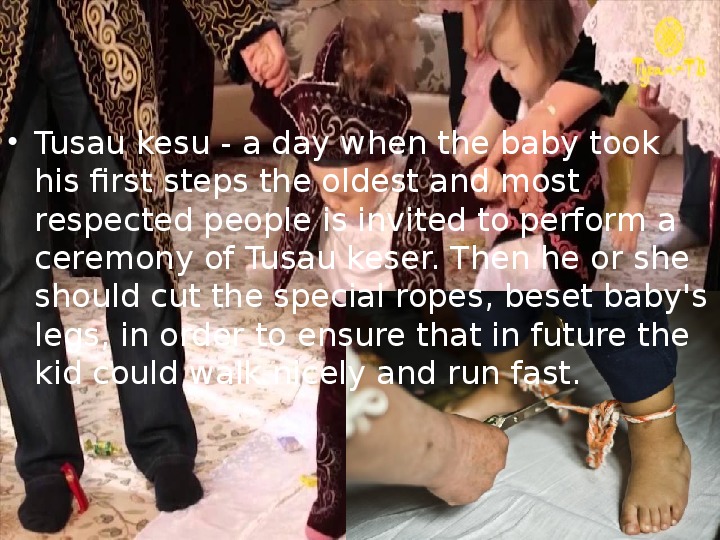
• Tusau kesu - a day when the baby took his first steps the oldest and most respected people is invited to perform a ceremony of Tusau keser. Then he or she should cut the special ropes, beset baby's legs, in order to ensure that in future the kid could walk nicely and run fast.
Kazakh traditions
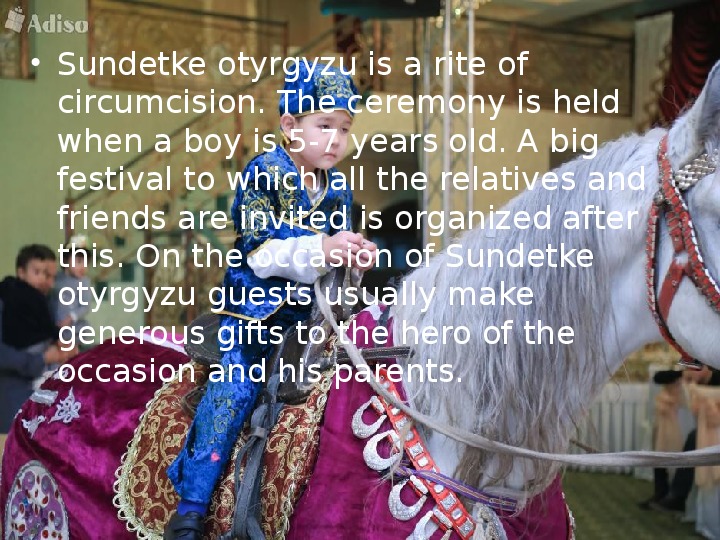
• Sundetke otyrgyzu is a rite of circumcision. The ceremony is held when a boy is 5-7 years old. A big festival to which all the relatives and friends are invited is organized after this. On the occasion of Sundetke otyrgyzu guests usually make generous gifts to the hero of the occasion and his parents.

Активировать у студентов знания об обычаях и традициях нашей страны, научить студентов искать и изучать необходимые материалы сами; познакомить учащихся с праздниками и традициями в Казахстане; закрепить и обобщить знания учащихся по теме “праздники и традиции в Республике Казахстан”; обогатить знания учащихся во всех сферах Страноведение; расширять словарный запас через выполнение различных заданий.
Holidays. Traditions and customs in Kazakhstan
Мақсат The aims:
Білімділік educational: • teach logical statements relating, in a speech to intensify LES students on the theme "Tradition and Holidays";
Дамытушылық developing: develop interdisciplinary communication and educational interest of students; develop skill dialogues and monologues, the ability to conjecture, imagination;
Тәрбиелік cultural: develop an interest in the culture of their own country; foster respect for the culture of the country the language is spoken.
Сабақтын типі (тұрпаты)
Verbal visual teaching method
Сабақтын барысы Ход урока
1. Бағдарлану – мотивациялық блок Мотивационно – ориентировочный блок
Сабақтың тақырыбын шығу, жазу
Выход на тему, запись темы урока
Good morning, children! I am gland to see you. Today we shall speak with you about the most famous holidays and customs of Great Britain and compare with Kazakh ones. We also shall revise lexical and grammar structures. I hope that it will be interesting for you during our lesson.
Оқу мақсатын қою
Постановка цели, задач урока
Сабақтың барысымен танысу Знакомство с ходом урока
Білім жаңғыртуы Актуализация знаний
Look at the blackboard, please, and find the right date for every holiday in our country:
the Day of Knowledge
The 1st of September
For example: On the 8th of March we celebrate Women’s day.
2. Жана материалды мазмұндау (баяндау)
Изложение нового материала
Kazakhs have always revered and highly valued their national customs and traditions. It is almost impossible to describe all the traditions followed by Kazakh people in one article, thus a brief introduction to Kazakh beliefs and customs is given below.
The main tradition of Kazakhs, which eventually transformed into a feature of national character, is hospitality. In the Kazakh society, there is an unofficial law voiced in ancient times, which says “Meet a guest as the God's messenger”.
Hospitality is considered a sacred duty in the Kazakh society. At all times, the steppe inhabitants did their best to please their guest. Therefore, each traveller knew that he or she would be welcomed anywhere in the Kazakh land.
Respect for the elderly is another positive feature of Kazakhs. Traditionally, a child from early childhood is taught to be moderate and honest when dealing with older, wiser and life experienced people.
However, the above mentioned national identities that served as a basis for the occurrence of generalized rules and principles of public relations (tradition), fortunately, are confined not only to representatives of the Kazakh people. Therefore, we offer to your attention a list of basic and authentic customs, which are widespread in the Kazakh society.
1. Traditions and customs associated with the guest reception
Travellers in Kazakhstan are most likely to be encountered with the traditions, associated with guest reception. Here are some examples of them:
Konakasy - a custom associated with treating of a guest. As mentioned above, Kazakh people since ancient times have been famous for their hospitality. Kazakhs always reserve the tastiest food for guests. Guests are divided into three types: "arnayy konak" is a specially invited guest, "kudayy konak" - a random stranger (uninvited), "kydyrma konak" - an unexpected guest. All these guests, despite of their type are offered a rich table – Konakasy.
Konakkade - a tradition under which a host has a right to ask a guest to sing a song or play a musical instrument (of course, as long as a guest is known for his or her talent), thus ensuring some fun and joy during the feast.
Erulik - if new settlers came to a village erulik was arranged in their honour, i.e. a small celebration that allowed newcomers to quickly adapt to the new location. Also, the custom erulik includes assistance in settling of the newcomers, when neighbours provide them with firewood, drinking water, etc. for the time being.
Toy dastarkhan - a special form of celebration, organized for holiday or during it. Sports competitions, music, singing competitions (aitys) and horse riding competitions are organised in addition to the gatherings during Toy dastarkhan. Very often, dishes of Kazakh national cuisine are served during such occasions.
2. Traditions and customs associated with gift giving
Guests are very often have to receive or give presents; in addition, there are often times, when gifts should be given in some special occasions according to the traditions. Some examples are given below:
Suyіnshі - a custom according to which a traveller or any other person who brought home a good message (news) receives a valuable gift from the owners in gratitude. Sometimes before telling good news a person says ‘Suyunshi’ or ‘what would you give me for a Suyinshi?’, thus implying that he or she has something great to tell.
“At mingizip shapan zhabu" is a high honour. According to the tradition, a respected visitor, who may be a poet (akin), a hero, warrior (batir) or other very respected man receives a gift from local residents: a horse and a splendid shapan (robe of camel's hair with a cotton lining) in recognition of their merit.
Baygazy - a tradition of giving a gift to a person, who acquired a new valuable thing.
3. Traditions and customs associated with mutual aid
Helping each other has always been highly valued by Kazakhs and is very important in a Kazakh community. Therefore, there are a number of traditions, which are associated with mutual aid. Some of them are listed below:
Asar - a family, which has to perform an urgent and sometimes a hard work, has a right to ask relatives, friends and neighbours for assistance. At the end of the work, a rich table is laid as a gratitude for those, who helped.
Zhylu - a tradition associated with the provision of material, moral and financial assistance to people affected by natural disasters (fire, flood, etc.). All supporters, not only relatives are entitled to help the victims. Many things can be given as donations - livestock, building materials, clothing, money, etc.
Belkoterer - a tradition to treat the elderly. Delicious and most importantly - soft foods such as kazy, zhent, cottage cheese are cooked for the elderly. Typically, this responsibility rests on children or close relatives, the less likely neighbours. Belkoterer tradition is an example of caring for the elderly.
4. Traditions and customs associated with birth and upbringing of the child
Traditions, connected with the birth of children and their upbringing, apparently play a very important role in many cultures. Just a brief description of such rituals and traditions followed by Kazakh families, is given below. All of these rituals are usually followed by celebrations.
Shіldehana - a celebration that is associated with childbirth.
Besіkke salu, besik toy - a holiday, hosted when the newborn is put to a cradle - besik. As a rule, it is organized on the 3rd-5th day after dropout of umbilical cord of the kid.
Kyrkynan shygaru – a ritual performed on the fortieth day after birth that includes bathing baby in 40 tablespoons of water, and the first haircut and nail cut and other rituals.
Tusau kesu - a day when the baby took his first steps the oldest and most respected people is invited to perform a ceremony of Tusau keser. Then he or she should cut the special ropes, beset baby's legs, in order to ensure that in future the kid could walk nicely and run fast.
Sundetke otyrgyzu is a rite of circumcision. The ceremony is held when a boy is 5-7 years old. A big festival to which all the relatives and friends are invited is organized after this. On the occasion of Sundetke otyrgyzu guests usually make generous gifts to the hero of the occasion and his parents.
5. Traditions and customs related to marriage
One of unique Kazakh traditions related to marriages is that the marriage between relatives up to the seventh generation is prohibited. Such taboo helps to prevent blood mixing and, consequently, benefit to the health of future offspring.
Traditionally, sequence of the ceremonies and rituals related to a marriage is the following.
Any wedding ceremony in the Kazakh society is anticipated by kudalyk (matchmaking). Before the wedding, matchmakers come to bride's house. Their task is to agree with the closest relatives of a girl on her marriage. During courtship, father of the bride receives gifts from the guests that serve as a deposit.
If negotiations are successful, the father, in turn, presents a coat to the main matchmaker. This custom is called “Shege Sapa”. Preparation of "kuyruk bauyr" - a delicious dish from the liver and broad tail fat also testifies to the successful completion of courtship.
The next stage of the ceremony is sendoff of the bride Kyz uzatu. In the evening before the Kyz uzatu matchmakers come to the bride's house again. Number of visitors should not be even (5-7). Early in the morning, the bride with matchmakers is sent to the groom's house.
Solemn ceremony of meeting the bride in the groom’s house is called kelіn tusіru. The main element of kelіn tүsіru is a traditional performance of a song of instructions and wishes - Betashar.
In ancient times when the Kazakhs practiced a nomadic lifestyle, dwelling (yurt) of newlyweds was located behind the house of groom’s parents. According to the tradition, the first threshold of the yurt was to be crossed by the bride, and be sure to do it with the right foot. Also during the wedding ceremony, the couple must drink together a bowl of water with dissolved sugar and salt. This ritual is considered as a guarantor of a happy family life.
6. The most ancient traditions of Kazakh people
Ashamayga mingizu is a ritual whereby a 6-7-years-old boy was supposed to be given a horse and whip. Such a ritual is a kind of "initiation", having proclaimed that the child is a jigit. On this day, elders blessed the young rider and parents organized a small celebration in honour of their son.
Bastangy is an ancient analog of contemporary youth parties. Traditionally, these celebrations are conducted immediately after departure of adults. During Bastangy, guests express only one wish that the travel of the adults would be accompanied by luck.
''Kazakh national food''.
- Baursacks - it's made from flow and fried in the oil.
- Kymyz it's our national drink. It's a horse milk.
- Kurt it's made from airan.
- It's a horse meat zhal - zhaya and kazy. It's boiled in the water.
- Irimshik made from cow's milk.
3. Рефлексия бақылау блогы Рефлексивно – оценочный блок
Білімдерін бекіту Закрепление знаний
Tusau kesu
- This ceremony is held when a baby makes first steps.
- The ceremony doesn't accompined by songs and wishes.
- A future jigit must be able to agree with difficulties.
- A very respected person who has many children cut the hobbles.
Ashamaiga minguzu
- Ashamaiga minguzu it isn't one of the sure methods of upbringing.
- A little boy 6 or7 of age is presented by saddled horse.
- It's explained to the father that he has become a jigit.
- The adults organize a little toi.
Answer the questions:
- What is Altybakan?
- What is Kazakh for sticks?
- Who constructs the altybakan?
- In what part of the day do the young people gather near the altybakan?
- How many sticks is used to construct altybakan?
Нәтижелерді жинақтап, қортындылау
Обобщение результатов, подведение итогов Marks.
Рефлексия What's new on the lesson learned? Are you curious about other holidays UK? About what?
Читайте также:

